Talybont Reservoir (2019)
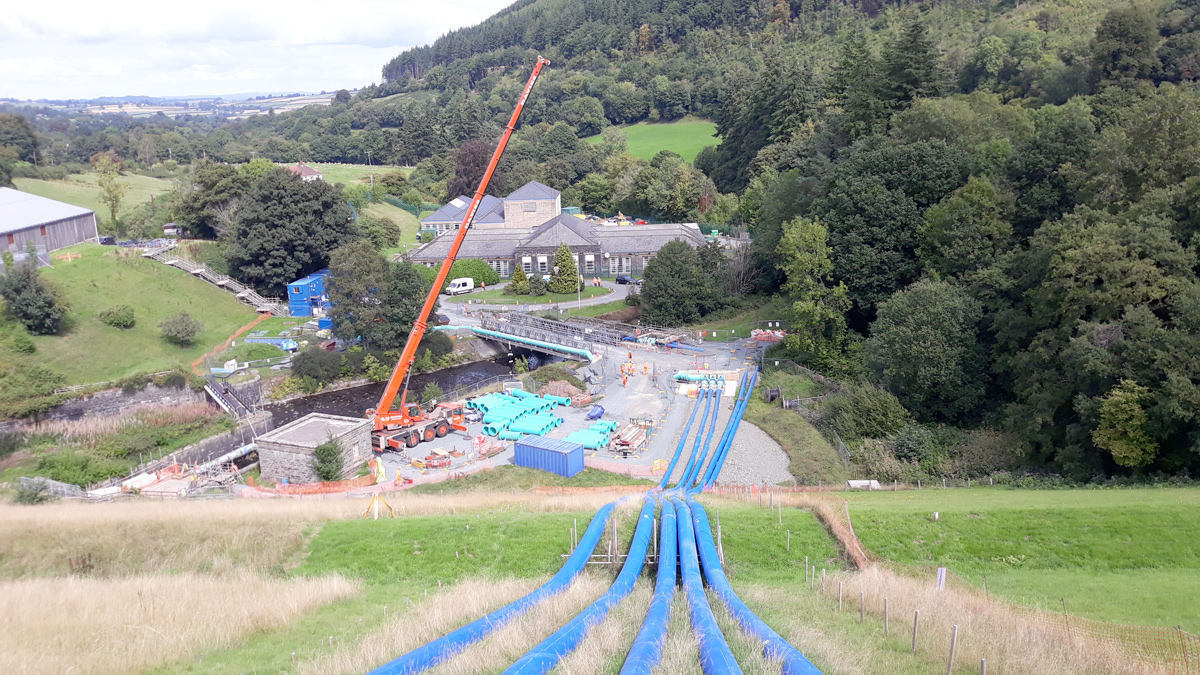
View from dam crest showing siphon pipework and site set up - Courtesy of Dŵr Cymru Welsh Water
Talybont is a Large raised reservoir situated in the Brecon Beacons National Park approximately 30 miles north of two of the most populated cities in Wales; namely Cardiff and Newport. Construction of Talybont Dam began in 1932 and ran through until 1939. It was conceived out of a requirement to supply treated water to the rapidly evolving population of the City of Newport. Clay was won locally in a borrow bit upstream of the proposed dam site and stone was quarried locally to provide for masonry blockwork to line the spillway channel and face the tower and upstream face of the embankment.
Talybont Dam
Talybont Dam is designated as Category A – High Risk and the reservoir is impounded by a 30m-high Pennine type, earth-fill embankment dam with a puddle clay core that was constructed above a substantial concrete cut off wall. The surface area of the reservoir occupies 127.2 ha of the Caerfanell River Valley, with the total storage capacity estimated to be approximately 11.6Mm3. The reservoir currently supplies drinking water to around 45,000 properties along the Usk Valley Catchment, and water can be drawn from the reservoir at three levels within the 4m diameter draw-off tower. There is a continuous 180m long by 4m diameter mass concrete tunnel which runs through the dam foundation cut off wall and is plugged approximately 20-30m upstream of the clay core.
The horseshoe shaped tunnel housed a 31” concrete lined steel main which supplied water to the water treatment works (WTW), and also served as part of the emergency drawdown facilities with a 600mm washout to the tail-bay. The 25” cast iron scour main also washed out to the tail-bay with a 12” branch off supplying a hydroelectric turbine at the toe of the dam. In combination the two mains provided 610mm of drawdown capacity under median inflow conditions or a Q50 event.
The Dam accommodates flood passage over a 90 m long curved broad-crested weir, which discharges into a large block masonry spillway channel, backed with a substantial concrete liner. There is a requirement as part of the abstraction licence to provide compensation releases to the downstream river of 25ML/d which would normally be discharged through the turbine outfall.
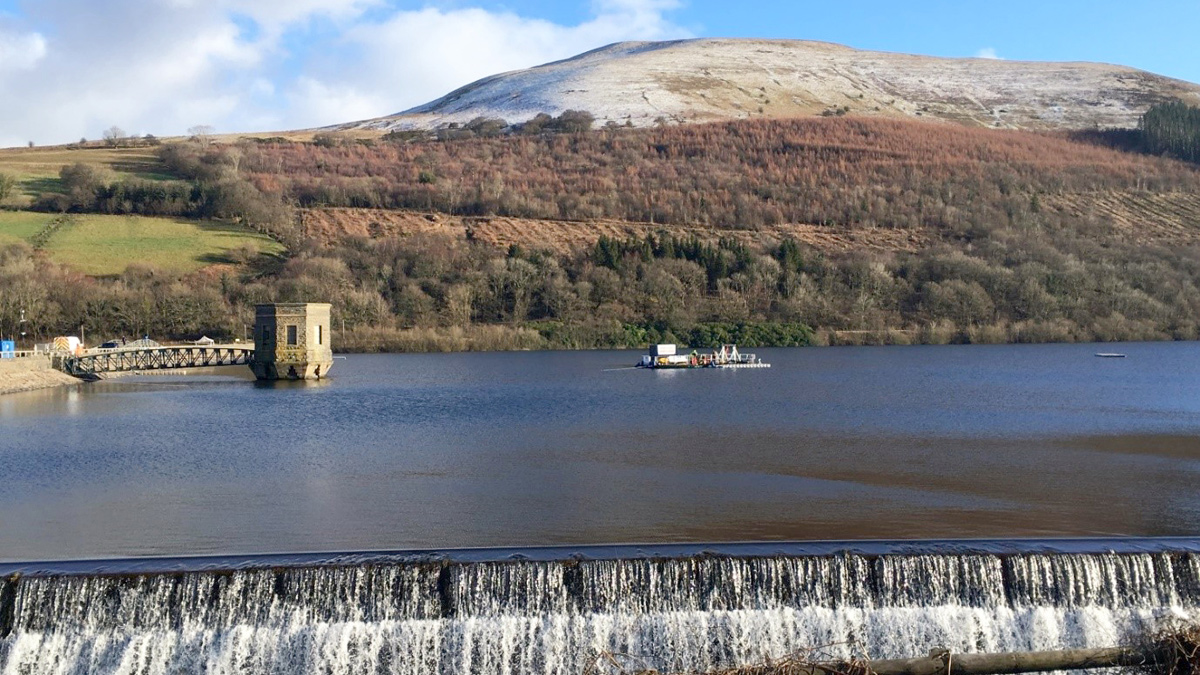
Talybont Reservoir with draw-off tower & broad crested weir – Courtesy of Dŵr Cymru Welsh Water
Incidents
There have been two significant incidents at Talybont over the past 30 years, both of which were associated with the pipework within the dam. There is little evidence available on the causation of the first other than brief historical records. However it is clear to see that there were significant works required to replace part of the vertical stack and the top draw off connection. The more recent incident occurred in June of 2015 when a large section of the 25” cast iron scour main ruptured resulting in a considerable release of water within the tunnel.
The events described above instigated a capital intervention project at Talybont with a high-level design brief:
“The full replacement of the steel raw water main, cast iron scour main and all associated valves within the tower and tunnel of the dam. The new system is to be sufficient to provide the same flow rate to the works and have a 100 year life expectancy.”
This brief came with numerous site specific constrains which were not limited to:
- Reservoir level cannot be reduced significantly to facilitate works.
- Age of the existing assets within the tower and tunnel.
- Maintaining supply to the WTW and compensation flows.
- Isolation of equipment must conform to DCWW standards.
- Dam crest road must remain open to traffic at all times.
- A maximum 44T weight limit is in place on the dam wall road.
- A maximum 2T weight limit for plant that tracks along the berm of the reservoir.
- No excavation works are to be undertaken in the dam structure.
- Confined space working and specialist diving activities.
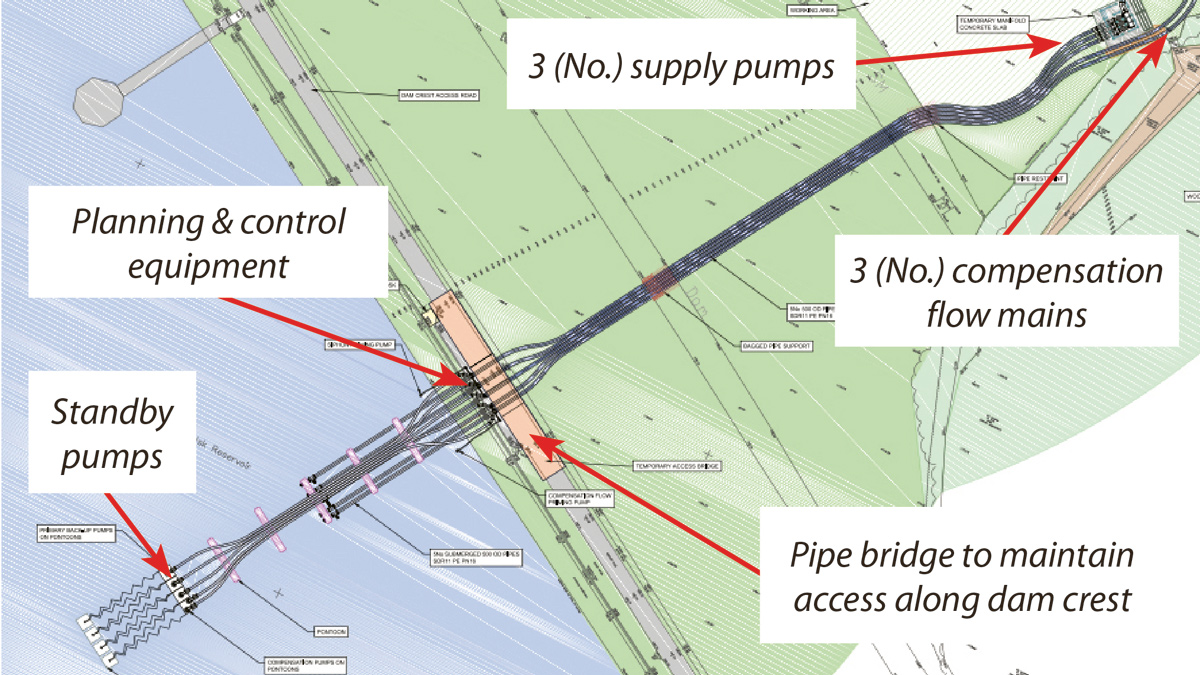
General arrangement of temporary siphon system – Courtesy of Dŵr Cymru Welsh Water
Isolations
With no existing means of providing upstream isolation, fulfilling the brief of full replacement of all valves and pipework without emptying the reservoir posed a considerable challenge.
Each of the two pipes (scour & supply) pass through the plug of the reservoir and has a bell mouth approximately 400mm from the upstream face. It was not possible to safely use divers to attach a blanking plate or valve to the upstream end of the pipes due to the risks associated with the reservoir depth (30m) and tunnel length (60m). At an early stage of the project the team set about exploring innovative solutions to this problem.
The use of remote operated vehicles (ROV) for marine activities and tasks have been undertaken for many years with varying success. At Talybont Reservoir it was decided to explore the use of a ROV to undertake the upstream isolation of both mains from within the upstream tunnel.
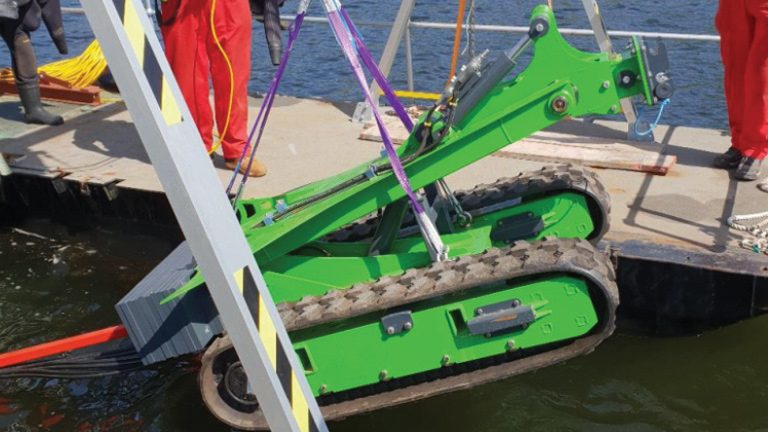
ROV being lowered into the reservoir from the diving pontoon – Courtesy of Dŵr Cymru Welsh Water
To remove the valves for replacement it was necessary to rely solely on upstream isolation. The bellmouths were surveyed using the ROV camera and based on the condition it was decided that the risk of sealing within or on the bellmouths was too high. This led to the development of the ‘Top Hat’ isolation device.
This comprised a 1200mm diameter pipe section, sealed at one end, placed over the bellmouth and sealed against the upstream face of the plug using a 25mm-thick neoprene sealing ring. The top hat was attached to the ROV and then transported by the ROV through the tunnel to the plug.
Maintaining supply
Maintaining a continuous supply to the WTW and compensation flows required a great deal of thought and temporary works. Traditionally, the default solution would have been to use diesel pumps. The design team discarded this option early in the project due to a number of concerns, these being:
- The space required to locate the pumps and equipment.
- High costs of hire and fuel.
- Environmental issues including potential refuelling and noise pollution.
- 24-hour manning to manage flows to works (as flow profile changes throughout the day).
- Duty/assist/standby arrangement for maintenance of the equipment.
- The lack of suitability of pumps with a high suction head requirement should reservoir levels fall significantly in dry weather.
From further investigation, the elevations of dam crest and reservoir water level were such that siphoning the required water was possible. Thus, the final solution comprised five siphons with a secondary (standby) electrical submersible pump arrangement. Three of the siphons would be used for the supply to the WTW and two used to provide permanent compensation flow.
The three supply pipes were connected to a common manifold beyond the downstream toe of the dam into a single 700mm diameter pipe leading to the WTW.
Benefits of the siphon system
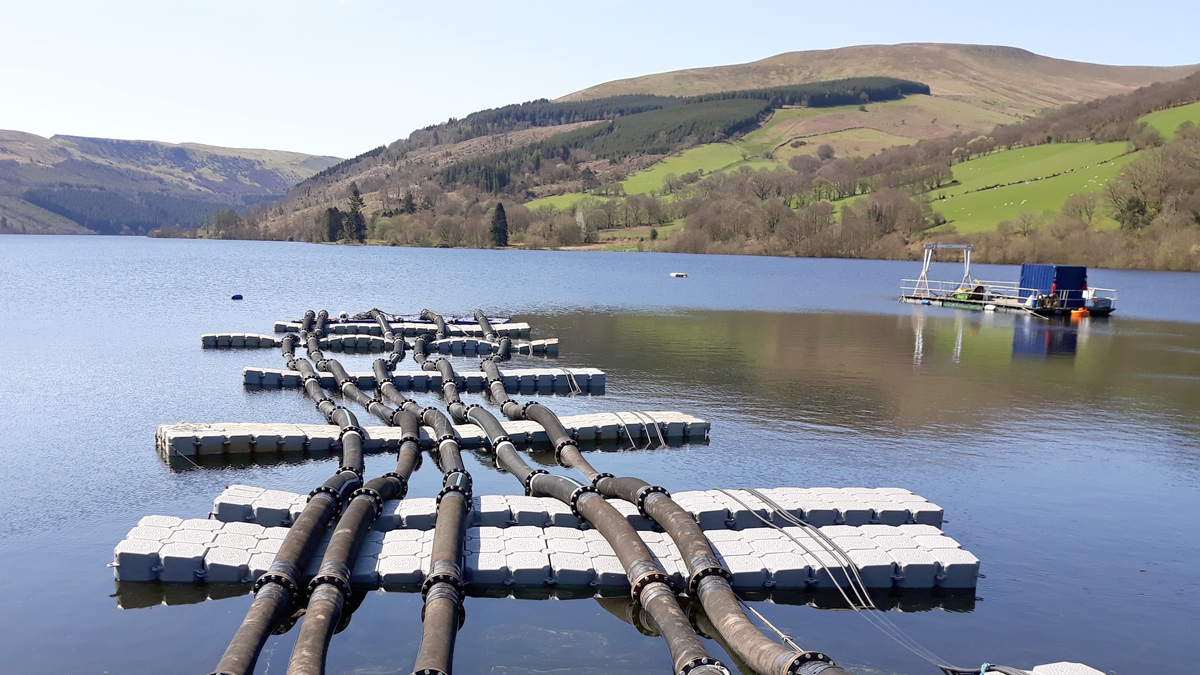
Overview of the siphon system and associated pipework within the reservoir – Courtesy of Dŵr Cymru Welsh Water
The benefits of the temporary siphon system were significant and far reaching. Environmentally, the siphons did not require any power (once in operation) and did not produce any noise. In contrast, a diesel pump would require daily diesel deliveries; produce engine noise and have a high potential for fuel spills in the vicinity of water intended for human consumption.
The siphon system had been designed to ensure minimal impact to DCWW production. Other than the repositioning of dosing and sampling lines onto the temporary system, the control of flow and quality remained the same. This was a real bonus as the local production technicians continued to operate as business as usual and did not require any additional training or operational changes. Compounded to this was that works capability remained unchanged and raw water quality was unaltered with the use of the temporary system.
Customer impact was a key consideration during the design phase. Talybont WTW supplies a large network which cannot be supplied easily from other sources. Therefore, there was a significant amount of resilience built into the temporary system. Separation of siphons into a number of branches ensured the continued supply of water even with a failure in a siphon branch. Also, in the event of a complete failure of siphoning ability, there was a secondary standby set of electrical submersible pumps able to deliver raw water flow to both the works and river. Indeed, during operation of the temporary siphon system, we experienced the driest summer period on record and unprecedented flow demand. Due to the low reservoir water level, the ability to siphon ceased and the electrical standby pumps were deployed with no resultant impact to the customer.
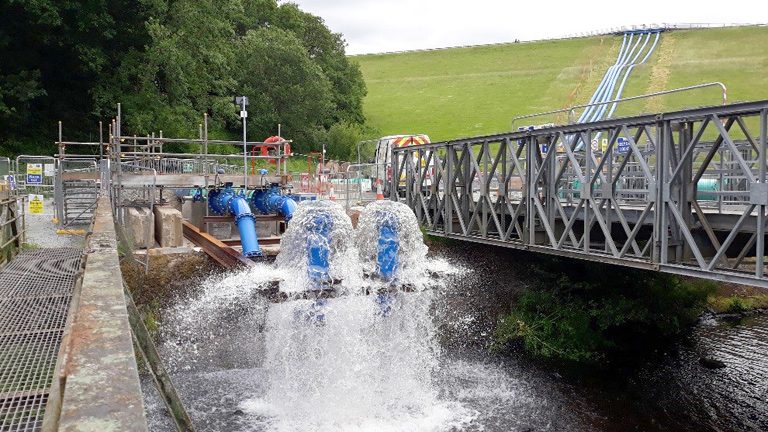
Compensation flows supplied from the siphon system – Courtesy of Dŵr Cymru Welsh Water
Design details
The configuration of the new 800mm valves and pipework that have been installed allow for double isolation on both the supply main to the WTW and the scour main. In addition to this isolation, there are now cross connections between the supply and scour mains. This function allows the scour main to be supplied from the draw-off stack pipe and also for each main to be isolated independently whilst still providing compensation flow and supply to the WTW.
The design of the new pipework also incorporates dismantling joints at key locations that will allow sections of pipework or components to be removed should the need arise in the future. The new guard valves were fitted with actuators allowing operation from the top of the draw-off tower, removing the need for operatives to enter the confined space to operate valves manually.
The works to remove the existing pipework and complete the installation of the new were undertaken by Lewis Civil Engineering – now (Dec 2022) Envolve Infrastructure – who were also the principal contractor for the project. The tower works were undertaken by their mechanical sub-contractor TEMA.
Talybont Reservoir: Supply chain/key participants
- Client & designer: Dwr Cymru Welsh Water
- Principal contractor: Lewis Civil Engineering (now Envolve Infrastructure)
- Geotechnical investigation: Geotechnics Ltd
- Specialist diving contractor: Edwards Diving Services
- QCE & NEC supervision: Mott MacDonald
- Confined space control: Mines Rescue
- Pipework supplier: UTS
- Mechanical sub-contractor: TEMA
- Electrical sub-contractor: Celtic
Diving works
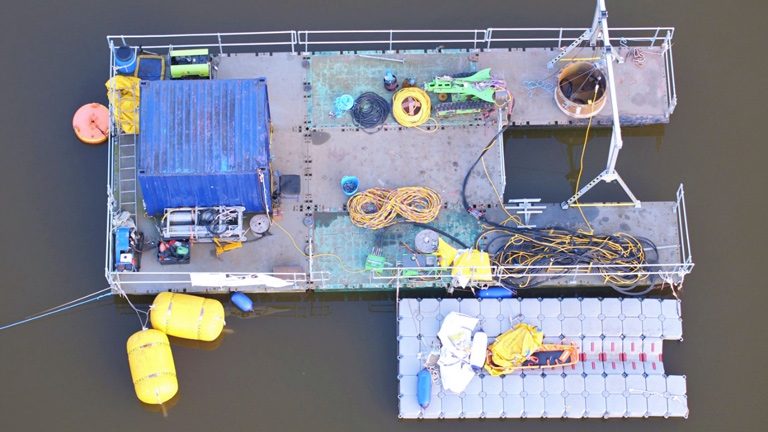
Diving station on the reservoir – Courtesy of Dŵr Cymru Welsh Water
The industry standard and approach carried out prior to this project would have either been to drain the reservoir or install blank plates using a dive team. However, given the depth of the dive required at this reservoir and also the horizontal swim distance of the tunnel this option was not feasible. Draining the reservoir was not possible as it is the sole supply to the WTW and the downstream network cannot be completely supplied by alternate source.
Edwards Diving Services undertook a tactile physical survey and sonar survey of the tunnel, bellmouths and plug face, allowing the size of the ROV and the Top Hat to be developed. A value engineering exercise was undertaken to ensure the Top Hat was robust enough to provide the isolation while still being light enough to be transported up the 60m tunnel by the ROV. Once fabricated it was then tested under positive and negative atmospheric conditions.
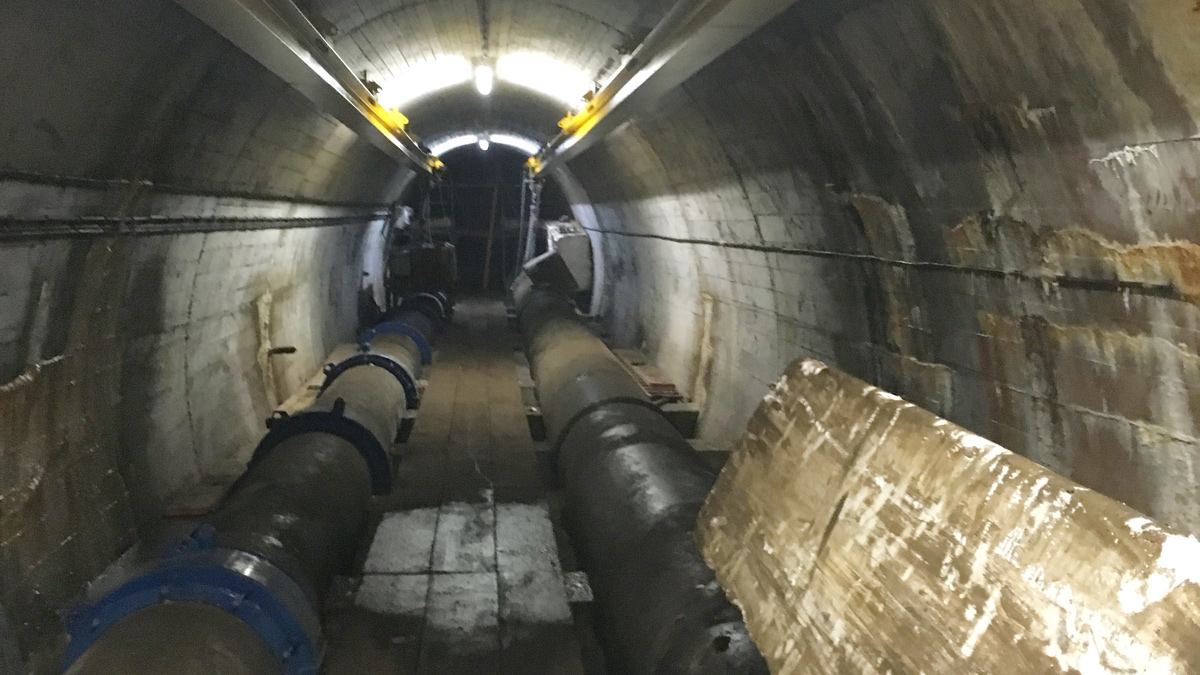
View of existing pipework within tunnel – Courtesy of Dŵr Cymru Welsh Water
At a depth of 30m, diving ‘bottom time’ was limited to 25 minutes which resulted in the existing 6-man team being supplemented by an additional two divers. A decompression chamber was positioned on site to allow divers to enter within minutes in the event that something did go wrong.
The supply and discharge pipes associated with the temporary siphon system were particularly heavy and without a crane, Egyptian style lifting techniques were used to deploy the siphons to the required draw depth of 21m. All the flanges, valves and non-return valves were assembled underwater, with the siphons being approximately 30m long and the pump bagging around 45m. The pumps were secured to a number of concrete blocks 50m away from the reservoir bank.
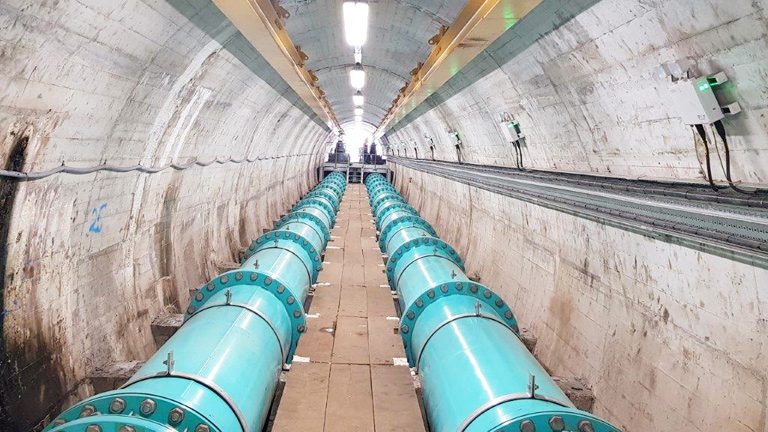
Completed 800mm pipework within tunnel and overhead lifting beams – Courtesy of Dŵr Cymru Welsh Water
Final outcome
The upstream isolation that was achieved through the ROV and Top Hat has allowed full replacement of all valves and pipework, achieving the primary objective of the project. Without this isolation, existing valves that did not fully seal and sections of original pipework would have been left in situ presenting a weak point in the system requiring removal in the future with potential draining of the reservoir.
The development of the ROV and Top Hat technology will be used in future projects of a similar nature where upstream isolation is required to allow refurbishment and replacement of strategic infrastructure. In terms of benefits to Welsh Water and its customers, this project has delivered an asset that is now resilient for future generations. The temporary works used on this project meant that the customers supplied by this asset had no interruption to their water supply during the entire construction phase.





